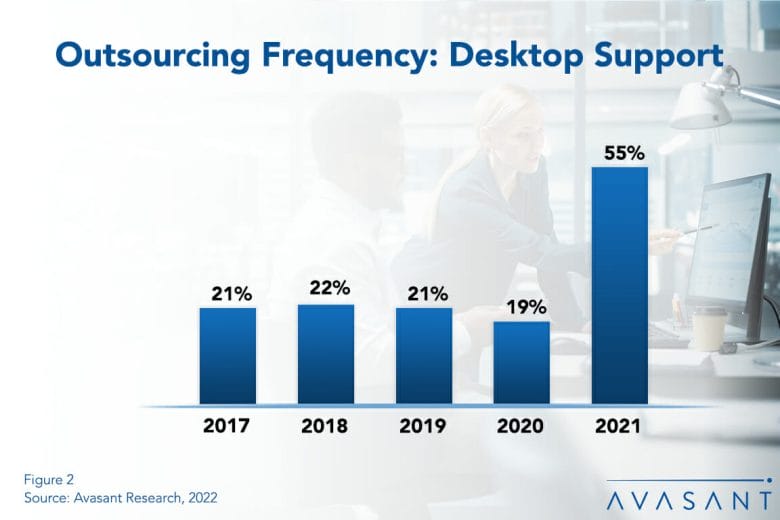The question of whether to turn over the desktop support function to a service provider is a critical and surprisingly complicated one. Our research shows that there is a strong cost advantage to outsourcing desktop support tasks, but many organizations have reported negative service experiences. CIOs must find balance in the delicate dance between cost savings and service success.
As shown in Figure 2 from our full report, Desktop Support Outsourcing Trends and Customer Experience, 55% of organizations outsourced at least some of their desktop support work in 2021. That is a significant jump from the 19% reported in 2020. However, it should be noted that our most recent sample has a larger percentage of large companies, which tend to practice outsourcing at higher levels than their small counterparts. This explains some of the jump, but certainly not all of it.

One influential factor in the analysis of this recent spike is the COVID-19 pandemic. Amidst global quarantine protocols, many organizations were forced to adopt remote and hybrid work models. With these new types of worker models, employee work devices were no longer centralized at one location but spread across their homes and shared spaces, increasing the complexities associated with desktop support outsourcing. Organizations faced the challenge of users receiving the same level of in-office support while working remotely.
Working against outsourcing is the fact that keeping desktop support in-house encourages contact between the business and the IT organization. Handing over that function denies a significant opportunity where IT can get closer to business users and better understand their needs and processes. Despite this and other reasons, the solid cost ratings make it worth looking into this practice.
“Organizations enjoy the cost savings that come with outsourcing desktop support,” said Reneece Sterling, a research analyst for Computer Economics, a service of Avasant Research based in Los Angeles. “Whatever issues they may find with service levels, ultimately those cost savings are hard to pass up.”
Desktop support technicians today commonly support local networks, phone systems, and printers, as well as IP networks that carry both voice and data to the desktop, and in some cases mobile devices. The relationships that desktop support technicians form with users can also be instrumental in improving user satisfaction. The presence of desktop support technicians in the field improves communications between users and the headquarters of the IT organization.
To help IT executives understand their options, the full study examines adoption trends in desktop support outsourcing. We measure desktop support outsourcing activity through outsourcing frequency, outsourcing amount (level), overall volatility, net growth trend, outsourcing cost experience, and outsourcing service experience. We also compare desktop support outsourcing frequency and level by organization size. Finally, the report examines the sectors that are most likely to outsource the desktop support function.
This Research Byte is based on our report on this subject, Desktop Support Outsourcing Trends and Customer Experience. The full report is available at no charge for subscribers, or it may be purchased by non-clients directly from our website (click for pricing).





